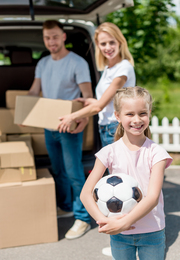Moving Safely: A Comprehensive Guide for Families
Whether you’re relocating across the state or the country, moving safely is the key, especially if you have kids. You’ll need to research schools, ensure that the area is safe for everyone in the family, and plan your move so that everything goes along seamlessly.
Having so many moving pieces to consider at once can be a lot to handle. However, with a solid strategy, you can make the move a success. This comprehensive guide provides advice on how to be safe and avoid stress when relocating your family.
Research Safe Places for Your Kids
As a parent, one of the first steps in moving safely is to research the city where you’ll be living to ensure that it’s safe and suitable for your children’s needs. Start by looking up crime statistics in the area and comparing them to other nearby areas to find the best place.
If your kids are still in school, look into potential school districts, so you’re sure they’re suitable for them during this stage in their lives. When considering school districts, it’s essential to research academic performance, which you can determine by looking up graduation rates and proficiency levels in various subjects, like reading and math. You should also look up each school and learn if it fits your core values. Finally, research the district’s safety measures. Do they have disciplinary policies and emergency protocols in place? Verify that they do.
Next, consider whether this neighborhood has safe areas for young kids to play. It’s good to have a place where children can unwind. Plus, time spent on the playground is good for physical health and helps them learn to communicate with others.
You should look up several factors when choosing a neighborhood with safe play areas, including traffic flow. Unfortunately, children make up a portion of pedestrian traffic facilities, so research the statistics in the area. Also, if you’re able to visit the city before you move, ensure that there are sidewalks, lower speed limits, and speed bumps on the street. You’re also likely to find a safer and more suitable place for your kids if there are more children in the new neighborhood. An area full of families with kids is more prone to have extra services and more play areas from which to choose.
Make Plans and Talk to Your Kids About Moving Safely
The last thing you want to do when your goal is moving safely with kids is to surprise them at the last moment with the news that you’re all leaving. Many young kids and teens likely have friends they’ve grown close to, schoolwork they’re excited about, and maybe even a part-time job to consider. You don’t want to make the process more complicated or dramatic.
That’s why it’s essential that you sit down and communicate with your children. Tell them why you’re moving and when you plan to depart, and then ask them how they feel. You may be able to ease their concerns and help them feel better about the whole idea. They’ll also know that it’s time to say their goodbyes and get a bit of closure.
You’ll also want to get your kids involved when completing your pre-move checklist, especially when heading across the country. That starts by determining a move date. If possible, push it out far enough so that you and the kids can manage your affairs. You may need to give your job notice, and your teens may need to do the same. You also need to inform their school and handle other miscellaneous tasks.
Another big step on your pre-move checklist is to start packing. If you’ve lived in your current home for a long time, you and the kids likely have many belongings to sort through. Allow the kids to be a part of the process, especially regarding their rooms. Everyone should separate items by what they want to keep, what’s trash, and what can be donated. If your kids have large collections of video games, guitars, or something else that takes up a lot of space, this may also be a good time to teach them about the value of self-storage.
Remember Mental and Physical Health
Keeping your kids safe and happy during the move is key, so consider their mental health. This transition is likely weighing on their minds. So, plan out the move so you’re not always rushing and that there are breaks to give you and the kids a chance to mentally refresh. A good idea is to get your kids a journal so they can write down their thoughts when they’re stressed and make a scrapbook of sorts to remember the experience. Once you get to the new home, continue to help your kids cope by getting them involved. Allow them to paint their room or choose the color and design.
Next, consider your kids’ physical health, especially when setting things up in the new house. If you have young kids at home, be careful when moving potentially dangerous substances, like medication, laundry detergent packets, and cleaning products. To protect yourself and kids of all ages, make it a point to prevent furniture tip-overs. Secure all large free-standing objects with mounts, braces, or wall straps and reduce the chances of a fall.
Finally, try not to take on too much at once. It may be tempting to have you and the kids do all of the heavy lifting and moving, but you need to stay safe. Hire movers to help with the load, and it will be easier for everyone.
Moving is a Lifelong Journey
As children mature and embark on new adventures, such as students moving to attend college, acquired skills that ensure safe and efficient relocations can be a great asset. Learning how to pack belongings securely, understanding transportation options, and familiarizing themselves with new environments are important steps in the process.
A big move can be tough on an individual or an entire family if you let it. With proper planning and consistent communication, it can become easier for everyone. Keeping kids of all ages involved can turn a daunting experience into a positive transition. Learn more about how to prepare your kids for a move. Check out this helpful infographic:
How-to-Prepare-Your-Kids-For-A-Move
Open PDF
About the Author
 Katie Brenneman is a passionate writer specializing in education, mental health, family lifestyle and online safety. When she isn’t writing, you can find her with her nose buried in a book or hiking with her dog, Charlie. You can follow her on Twitter.
Katie Brenneman is a passionate writer specializing in education, mental health, family lifestyle and online safety. When she isn’t writing, you can find her with her nose buried in a book or hiking with her dog, Charlie. You can follow her on Twitter.




